Ground Reports
Ground Report: How Mahakumbh 2025 Is Fixing The Mistakes of Mahakumbh 2013
Ankit Saxena
Jan 23, 2025, 07:42 PM | Updated Jan 27, 2025, 03:30 PM IST
Save & read from anywhere!
Bookmark stories for easy access on any device or the Swarajya app.


Prayagraj is hosting the grand Mahakumbh, also known as the Poorna Kumbh, which is held every 12 years.
From 13 January to 26 February 2025, a temporary city has emerged on the floodplains of the sacred rivers Ganga and Yamuna — with the Triveni Sangam – the confluence of these two rivers and river Saraswati – at the heart of the festival.
This year, nearly 40 crore pilgrims are expected to attend this holy gathering, where they will come to take a divine dip (snan) at the Triveni Sangam, making it the largest congregation of people, particularly Hindus, in the world.
The tradition of the Kumbh Mela has evolved over the ages, growing into a grand festival. However, despite its spiritual significance and scale, the event has historically been the site of many mishaps and tragedies.
While some issues arise unavoidably due to the sheer number of devotees, many also come due to gaps and mismanagement in the preparations.
In 2019, an Ardh Kumbh was held, which served as a smaller-scale trial for the current event. It was a Yogi Adityanath administration in power in Uttar Pradesh in 2019 as well.
A Mahakumbh however last took place in 2013, under the Samajwadi Party in Uttar Pradesh. Unfortunately, the 2013 Mela remains etched in memory for several tragic incidents.
As the Chief Minister, Akhilesh Yadav had the opportunity to set a positive example by making proper arrangements for the Kumbh Mela, however, events playing out during its duration suggested that the then UP government showed limited interest in the festival’s organisation.
“The stampede at the railway station during the last Mahakumbh claimed the lives of nearly 30 people. The huge crowd gathered at the station and led to this tragedy.”, a local shop owner at the current mela recalls.
This ground report focuses on the arrangements undertaken this year by the administration to ensure a safer, better-managed Kumbh Mela, as well as the measures taken with the shortcomings of 2013 and the learnings from the 2019 Ardh Kumbh.
But first, here are the key issues from 2013 that continue to serve as lessons for the organisers today.
All That Went Wrong in Mahakumbh 2013
The Mahakumbh of 2013 was attended by approximately eight crore devotees. By the time it concluded, the state government and authorities faced criticism for poor planning and systematic failures, leading to avoidable tragedies.
Stampede on Mauni Amavasya
On 10 February, during the Mauni Amavasya shahi snan, an estimated 3.5 crore devotees gathered. Inadequate arrangements to manage the returning crowd led to chaos at the Prayagraj railway station.
As per reports, overcrowding on platform number six resulted in a tragic stampede, claiming 36 lives and injuring 39 others. Police lathicharge added to the panic.
The state government blamed the Indian Railways, while both parties evaded accountability. Samajwadi Party minister Azam Khan, the chief organiser, resigned on moral grounds.
Fire Incidents
Multiple fires were caused by gas cylinder leaks and electrical short circuits posed significant risks.
On 25 January, a fire in Sector 11 killed five people and injured 23. Five days later, a blaze in Sector 2 destroyed three shops. In February, a short circuit in Sector 9 set ten tents on fire, killing one person.
Altogether, 67 fire incidents were reported during the festival.
Heavy Rains and Electrical Hazards
Unprecedented rains after the Basant Panchami shahi snan flooded the fairgrounds. Despite warnings from the meteorological department, no precautions were taken.
Roads turned to swamps, and kalpavasis’ huts were submerged. Around 50,000 Kalpvasis abandoned their stay midway. It took over a week to restore the grounds.
The festival’s electrical infrastructure, with hundreds of kilometres of high- and low-tension wires, was considered an ambitious achievement but remained unsafe.
Live wires crisscrossed waterlogged, canvas-built areas, posing risks to millions of devotees, especially under heavy rainfall.
Infrastructure Gaps and Management Issues
As per several reports, the temporary roads and bridges lacked accessibility for differently-abled individuals.
The CAG reported non-compliance with specifications in 81 of 111 infrastructure projects, resulting in substandard construction. Faulty planning caused financial losses of Rs 27.56 crore, while using low-grade materials added Rs 11.82 crore to costs.
Waste management remained heavily dependent on Prayagraj’s existing infrastructure, which struggled to keep up with the festival’s scale.
Pollution in the Ganga and Sangam also peaked, with Biochemical Oxygen Demand (BOD) levels exceeding permissible limits on auspicious bathing days.
The Transition With Ardh Kumbh In 2019
"The issues occurred as the government’s role in the 2013 Kumbh Mela was limited to approvals and administrative work," says a veteran professor who has been studying the Kumbh since 2005 in Prayagraj.
He tells Swarajya, "In the last Mahakumbh, the state never directly intervened, it was only a facilitator. However, the setup changed during the 2019 Ardh Kumbh. For the first time, there was direct attention from the government."
The direct intervention of the government brought a clear vision to the festival, which also changed its scale and experience.
This change aligned with the Yogi government’s inclination towards branding it as part of India’s growing religious tourism.
The 49-day Ardh Kumbh Mela saw 24.01 crore visitors, the highest footfall in its history till then.
This was a sharp rise compared to the 7.86 crore pilgrims at the Maha Kumbh in 2013, which included 3.5 lakh foreign tourists.
The Ardh Kumbh in 2019 saw over 10.3 lakh foreign visitors too.
“This year’s Mahaumbh is even on a larger scale, but the vision fundamentally changed during the Ardh Kumbh,” say Dr. Archana Singh, Coordinator of the Kumbh Study Centre (2019) at GB Pant Social Science Institute, Prayagraj.
There were evident transformations in the facilities provided.
Such as, in 2013, the Kumbh had around 35,000 toilets, but by 2019, the number increased to 1.2 lakh. This number also covered bus stops, parking lots, and roads, akharas and tent cities.
“Not just facilities, but for the first time, the approach was to include all. Now you see there are devotees from other countries, as well as from remotest tribes of the country”, Dr. Archana adds.
This inclusivity also extended to the traditionally marginalised groups. Participation from women sanyasinis and the Kinnar Akhada has grown over 2019 and 2024. .
In 2019, the Kinnar Akhada — a monastic order of hijras (a third-gender community) — debuted at the Kumbh and performed the sacred snan.
"Also, the mela as a space, economically, impacts people across all strata —from the largest corporations to the marginalised communities, who come here as vendors to sell traditional toys, religious literature, or and basic goods."
"For many of these vendors, there are no other markets like this. The mela becomes their biggest marketplace, where they can work for two to three months, with access to convenient food and shelter," Dr Archana adds.
The current government’s attention has not only elevated the scale of the festival but also reshaped it for showing India’s cultural richness to the world.
"Previously, the focus was just on the holy dip. Now, the Kumbh includes diverse religious and cultural activities." Dr. Archana tells Swarajya.
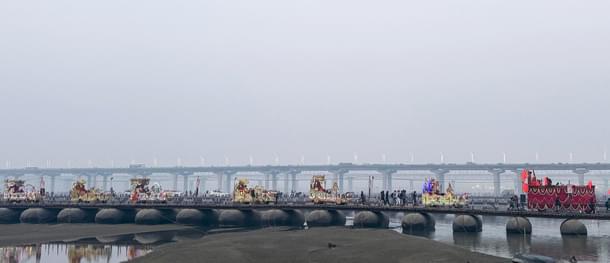
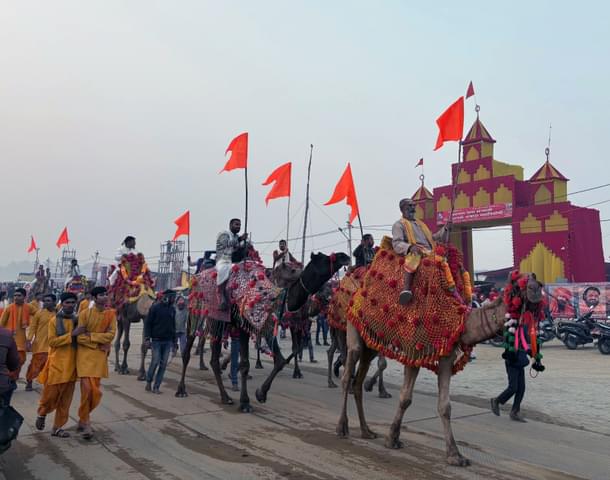
With Past Lessons, Preparations For Mahakumbh 2025
Many claim that most of the challenges that existed until 2013 were catered with the new approach during the Ardh Kumbh of 2019, but the ultimate test now lies ahead with the Mahakumbh of 2025.
In 2013, more than 3 crore pilgrims thronged the Sangam on Mauni Amavasya, the biggest bathing day, while this time, the expected turnout is estimated between 8 to 10 crore.
To meet this massive target, the Yogi government has taken complete control.
This involves planning for movement, stay, food distribution, health facilities, safety measures, fire, waste management, river water impact monitoring, and security protocols.
Construction efforts included nine paved ghats, seven riverfront roads, and 12 kilometres of temporary ghats. To manage the flow of devotees efficiently across the rivers, 30 pontoon bridges — eight more than in 2019 — have been developed.


As this grand event unfolds, the key question remains — how have the concerns of 2013 been tackled this time?
Railways
Most pilgrims traveling to and from the Kumbh Mela, rely on rail connectivity. This also brings the challenge of heavy crowds at stations and surrounding facilities.
The tragic incident in 2013, highlighted the need for a more robust plan for crowd control.
Mela officials note that the 2013 mishap was caused by misinformation and confusion, leading all pilgrims to gather at one station, causing overcrowding.
“We understand that the maximum crowd will head towards the railway stations. The city has nine functioning stations, and not all of them need to concentrate on the Prayagraj Junction,” an official from the Mela authority tells Swarajya.
To prevent any incidents this time, the traffic police and authority have designated "holding points" near the stations and along the routes. These areas will help manage the crowd by regulating the movement towards the stations.
“These holding points will be used when stations become crowded, helping our forces manage the flow,” the official added.
Additionally, clear information and directions are key to ensuring the smooth movement of pilgrims across stations.
Authorities have also prepared detailed plans on which station pilgrims should go to, distributing the crowd more effectively among the nine stations.
The holding areas were first set up during the Ardh Kumbh in 2019, and now, for the Mahakumbh 2025, these plans have been enhanced.
The teams have been working on these strategies for over a year as part of the larger mobility plan for the safety of the millions of pilgrims.
Crowd Management
Unlike a typical carnival or festival, Kumbh is attended by saints, devotees, and people with deep spiritual beliefs. Managing the crowd at the Kumbh Mela requires a sensitive approach, as it is not just any ordinary gathering.
Recognising this, authorities have strictly decided that no harsh methods will be used in crowd management.
The Kumbh Mela police have developed a detailed plan to provide etiquette training to around 30,000 policemen, including home guards, who will be deployed during the event.
This training aims to ensure that pilgrims are greeted with warmth and respect.
“The focus has shifted from traditional policing to handling the crowd with greater empathy. The personnel are trained in soft skills and sensitivity to help devotees, especially in case of emergencies or mishaps.”, a security official tells Swarajya.
"We have to remain vigilant for any signs of trouble, but our main goal is to assist and support the devotees,", she added.
Dr Archana Gupta adds, "The crowd here is different—there are saints, elderly people, and people who have come with faith and devotion. Interacting with them requires a different approach. It is encouraging to see that authorities are focusing on such practices, which will have a lasting positive impact."
Pilgrim Circulation
The focus of the pilgrimage circulation plan is on continuous walking along broad pathways, with minimal distractions or stoppages.
At the Kumbh Mela, all the Snan Ghats are considered equally important, and the focus is not solely on the Sangam area.
"Most pilgrims will be walking, so the plan focuses on reducing the distance they need to cover. This is now around 6 to 7 kilometres for most pilgrims. Previously, they had to walk 15 kilometres.", Mela Authority official tells Swarajya.
On days other than the Amrit Snans, vehicles will be allowed into the temporary city.
The mela city has 94 parking areas that can accommodate up to 5 lakh vehicles. The management is digitally enabled, allowing them to monitor parking capacities in real time.
"From nearly all parking areas, the Snan Ghats will be within a half to one-kilometre walking distance," the official added.
“Apart from walking, there will also be golf carts and shuttle buses serving remote areas and key points of interest within the overall Mela city. Large signages have already been installed in many sectors.”
However, on ground, wayfinding for many remains a challenge, such as to reach Akharas, Ashrams, food courts, or other temporary setups. To fix this, micro-level signages are being placed to guide pilgrims more precisely.
"Now that everything is set up in all the sectors, we have started placing these micro-level signages to guide people directly to specific Akharas and points of interest.", the official added.
(Read more on the pilgrim journey experience inside the Mahakumbh)

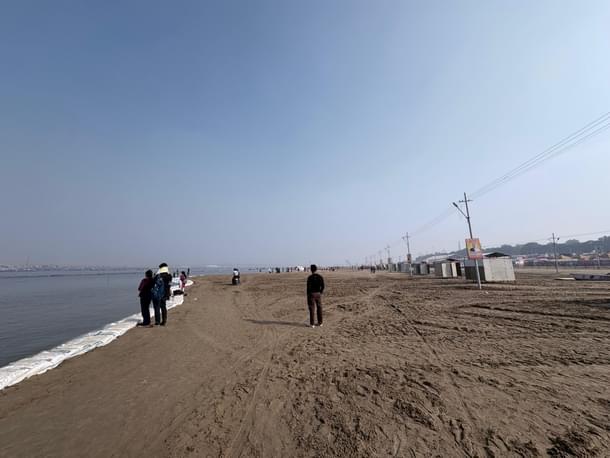
Fire Safety and Emergency
With past incidents, and as most structures are temporary and made of wood and fabric, fire safety has been a top priority.
Fire safety efforts for the mela began long before the tents and other temporary setups were put in place.
"The number of fire stations and chowkis has increased from 40 to 74 to cover the expanded areas of the Mela," said Aman Sharma, Deputy Director of UP Fire Services and in charge of fire and emergency services at the Mahakumbh.
With the cold weather, many of the sleeping arrangements for saints are also made using traditional materials such dry grass, which are also more susceptible to fire hazards.
"For the first time, 10,000 fire extinguishers have been distributed across all settlements. Previous melas have seen fire incidents, but this time, our focus has been on fire prevention and focusing on root causes," Sharma added.
As per mela officials, the fire safety team started their work at the planning stage of the Mela. They conducted rounds to study the sectors and plan safe routes before setting up any tents. A three-phase fire safety plan was implemented, focusing on early detection and prevention, well before the Mela began.
"During the Mela, smaller fire stations have been set up around each major Akhara for quick response. This year, there are also bikes and ATVs to navigate the sandy terrain and reach areas more swiftly," Sharma added.
Alongside this, specific guidelines on safety measures, such as on the use of gas cylinders, fireplaces, and electrical fittings, have been announced.
"Our response setup is also supported with advanced technology, with a larger force on the ground to respond to incidents like those reported in previous melas," he adds.
The arrangements were put to test as a major fire broke out in the mela on 19 January. It was caused by an explosion of cooking cylinders.
There were no reports of casualties. While the fire engulfed 18 tents, the situation was taken under control in 20 minutes by rapid action.
The fire was detected by authorities through thermal imaging from the watch tower and the next minute, a fire vehicle, which reached there, was pressed into action.
"Our setup allowed us to be able to respond to any fire incident within three to four minutes.", the fire officer tells Swarajya.
Within five minutes, 15 fire tenders were put into service to contain the blaze.

Electrical Hazards and Rain Preparedness
Adding to prevention of fire hazards, all electrical wiring at this year’s Mahakumbh has been installed in conduits, many of which are underground, to prevent any exposed wiring that could pose a risk.
Additionally, as a first, miniature circuit breakers (MCBs) have been installed across the site to avoid electrical hazards that could arise from short circuits.
Rain has also been a challenge especially for devotees who often face difficulties due to weather conditions.
This time, arrangements have been made to provide cover for the floating population.
Public accommodation has been set up with a capacity of 250 people per facility, and there are 113 such facilities across the Mela grounds. These facilities are available at nominal charges, offering shelter to pilgrims in case of rain or extreme cold.
In total, the Mela authorities have arranged for 25,000 more accommodation spaces than what is expected to be needed daily.


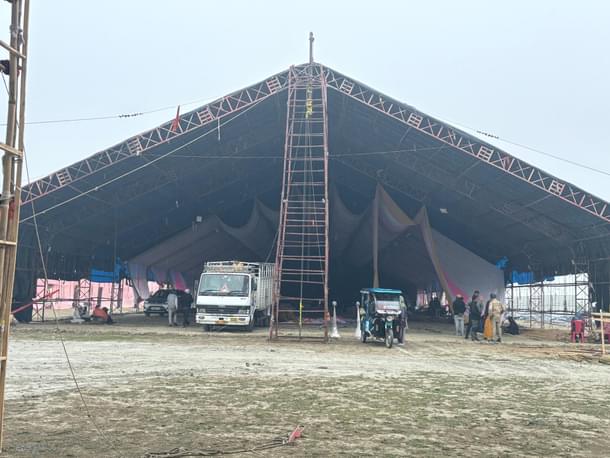
The Mela Experience
In an event of this magnitude, opinions about the arrangements remain divided.
When this writer visited the Mahakumbh right at its beginning (13 January), the sentiments within the Akharas were largely seen to be positive.
Mahants in Akharas told Swarajya, “The experience is great. From our entry to the mela, all authorities helped us set up our arrangements.”
They added, “We have attended four Kumbhs, and the facilities have completely changed now. Basics like taps, toilets, cleanliness have been thought of. Now it is our duty to maintain this till we are here.”
At the same time, some also continued to face issues. Another Akhara’s secretary tells Swarajya, “We are still struggling to set up our tents. The 2019 Ardh Kumbh was far better organised than this. Work is still happening everywhere. The management started the preparations late.”

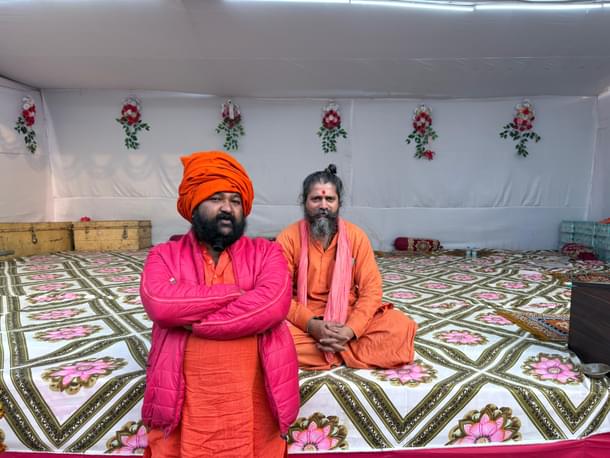
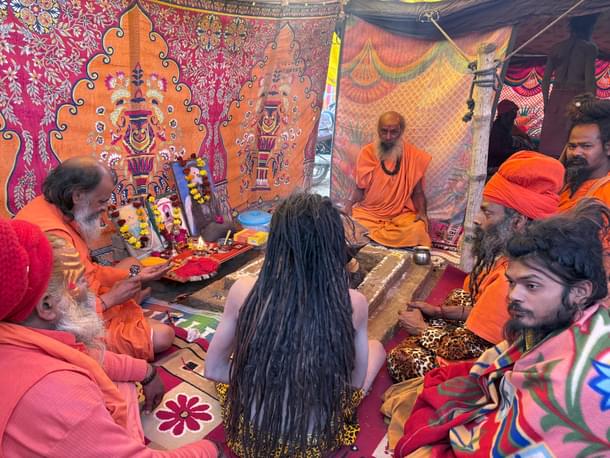
The initial days were also challenging in managing the circulation of public. E-rickshaw drivers were only allowed entry into the mela a day before its start.
“We do not know the routes yet. We have to keep asking security personnel, but they can also guide us only to the sectors. It will take time for us to manage,” shared a group of e-rickshaw drivers.
Throughout the mela grounds, many passengers and auto/e-rickshaw drivers could be seen arguing due to the same challenges.
Another issue raised was regarding concerns of locals over restricted access. “We are the people who have been seeing this mela for years and will continue to witness it in the future,” said a Prayagraj resident.
“The authorities should involve and build the local residents to participate and continue the functioning of the mela. Outsiders may see this as just another project, but for us, this is the city’s most known festival.”
The Yogi Adityanath-led BJP government has initiated 549 projects for the Maha Kumbh at a budget of Rs 6,990 crore. Officials estimate revenues of Rs 25,000 crore from the event, with an overall economic impact of Rs 2 lakh crore for the state.
Officials at the Mela Authority are positive about readiness. “All this has been set up within two months. Our work is on track. The ongoing work is targeted for 29 January, Mauni Amavasya, when more than 8 crore pilgrims are expected on the same day,” said a senior official.





